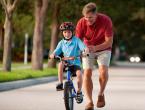Easy and fast: teaching a child to ride a two-wheeled bicycle
What could be more joyful for a parent than to see their baby happy and healthy? There are many activities that give children pleasure and at the same time strengthen the body. One such activity is cycling. How to teach a child to ride a two-wheeled model?
These questions are asked by parents who hear about the need to teach their child to ride a bike. Cycling is considered the most useful type of recreation for children (and for adults, by the way, too), because they:
- teach the baby to keep balance and better own his own body;
- develop the ability to navigate in the surrounding space;
- practice breathing with rhythmic movements.
These factors have a beneficial effect on the vestibular apparatus, muscles, respiratory and cardiovascular systems of a young organism.
The thirty-fifth President of the United States, John F. Kennedy, said: "Nothing compares to the simple pleasure of riding a bicycle."
You need to start practicing cycling with a child only when he himself shows interest in this type of transport. Otherwise, you can discourage the ride, and the baby will not want to learn at all. It is recommended to start with training on a tricycle no earlier than 3 years old, it is at this age stage that the child develops an interest in various types of movement, and the abdominal muscles that will be involved when riding a bicycle become already quite strong. Until this time, it is allowed to train with a child in an apartment or in a closed area. From 4–5 years old (after mastering riding on three wheels), you can transfer the baby to a two-wheeled model.

Cycling is not only fun but also good for your health.
Where to begin?
Before moving on to the practical side of the issue, attention should be paid to preparation.
First of all, you need to choose the right bike. If for a three-wheeled model the requirements are only that the structure must be stable and lightweight, then for a two-wheeled model this list is slightly expanded:
- pedals should rotate without much effort on the part of the “rider”;
- it is better if the brake is foot-operated so that the baby does not accidentally press the hand brake at the most inopportune moment;
- all appliances must be adjusted in accordance with the growth of the baby;
- the bike should please its owner from an aesthetic point of view;
- it is desirable that the model be equipped with additional small wheels that are mounted 2–2.5 cm above ground level to maintain balance.
The bicycle must be prepared for the child to ride on it:
- check the operation of the brake;
- adjust the steering wheel (it should be at the level of the baby’s chest, for the first time you can leave it at such a height that, in case of anxiety, the baby can easily stand on the ground with both feet);
- adjust the saddle so that the child's back is straight when the foot is on the lower pedal.
In no case do not neglect the purchase of a helmet, knee pads and elbow pads. Equipment must be made of durable materials. The helmet is supposed to be a multi-layered structure, consisting of thin plastic and foam-like filler. Some children's models are lined with soft fabric for added comfort and additional weather protection. Elbow pads and knee pads are made of plastic with a fleece lining, these items should fit the child’s legs and arms as tightly as possible, so you don’t need to buy them for growth.
After buying everything you need, you need to choose a place for training. A flat paved path away from the roadway is well suited. It is equally important that there are not many trees nearby, large stones do not lie on the side of the road, and there are no large crowds of people on the site (small children do not run or old people do not walk).
It is also necessary to theoretically shoe a child - teach him the rules of the road: talk about the places allocated for cyclists on the roadway, explain the meaning of road signs and traffic signals, teach him to look around, choose a route and watch for approaching cars.
How can I help my child learn to ride a bicycle?
Getting rid of fear

Try to start by simply carrying a child sitting on a bicycle, holding it by the saddle
The main obstacle to the development of two-wheeled transport is fear. Getting used to a two-wheeled satellite is a long process. You can significantly reduce it if the baby confidently rides a tricycle. To help your child overcome fear due to a possible fall, you need to:
- sit down and ride yourself;
- put the baby in the saddle;
- offer to put your feet on the pedals;
- ride the child, holding the bike by the saddle and handlebars.
If parents themselves love cycling, it will not be superfluous to take the baby with them.
We keep the balance
You can teach your child to keep balance in the following way:
- Learn how to get on and off the saddle. To do this, you need to tilt the bike in different directions, and the baby should put on the ground the leg in the direction of which the slope is going. So the young driver will learn how to prevent a fall.
- We release the bike, and we offer the baby to put his feet on the pedals. At the moment when the transport begins to fall to the side, the child must put out his leg.
You can also train balance on a runbike - a bicycle without pedals that helps the leg muscles get used to the tension, after mastering which it remains only to teach the baby to use the pedals.

Mastering a runbike helps a child learn to balance faster
We control the steering wheel
It is important to explain to the child that turning the steering wheel is movement in the appropriate direction. If the little one confuses left and right, then it makes sense to tie bright scarves or short but thick laces on different sides. At first, let the baby turn the steering wheel in the direction that you call him, but gradually he tries to make movements in the direction he needs. The main thing is that an adult does not grab the steering wheel - this way a child can get scared and get injured by making a sudden movement.
Braking and pedaling
It is always easier for children to jump off the saddle and brake with their feet than to use the pedal, but there is a risk of injury. Therefore, we gain patience and teach proper braking:
- We carry a bike with a child.
- We suggest you press the brakes and put your foot on the ground.
- Let's leave the bike.
At first, the baby can pedal while the adult supports the bike. Gradually, it is necessary to teach the child to combine scrolling and braking. At short distances, you can push the baby, staying close in case of unforeseen difficulties.
If the child trained on a run bike, then you need to do the following:
- Unscrew one pedal and lower the seat so that the baby reaches the ground with his feet.
- Learn to brake with one pedal, resting your foot on the ground, and then screw on the second pedal.
- To move down a hill with a child - reflexively, the baby will begin to pedal.
- Raise the saddle to the desired level and work out the skill of riding further, at first holding the child by the shoulders.
You can complete the development of a bicycle with a small exam: let the kid drive off a small hill, independently completing the entire sequence of actions - sit down, pedal, slow down and rest his foot on the ground.
We fix the skill

Even when the child learns to ride a bicycle, it is necessary to continue to monitor his movements for some time.
It happened: the baby can ride a bicycle without outside help. Many parents sigh with relief and leave the child alone with his transport, which should never be done! Children take a long time to adapt to new skills, and this is also the case when riding a bicycle: today the child rides confidently, and tomorrow he may fall without even touching the saddle. Repeat the theory with your child every day before the trip, and then arrange a kind of test: let the child ride in the prescribed place at the pace that you choose for him - the children enjoy playing such an exam.
How to teach to ride a bike with extra wheels?
Another effective way to teach a little one to stay in the saddle and pedal is to master a bicycle with side wheels. The kid needs to be explained: despite the similarity with a three-wheeled vehicle, this is a completely different model, and some tricks on it (for example, a sharp turn) are simply impossible. The technology of learning on such a bike is identical to that used in the development of a two-wheeled friend. But there is a little trick. As already mentioned, small wheels are installed slightly higher than large ones. When the baby begins to ride more or less confidently, they will need to be raised. Over time, you can get rid of additional insurance altogether.
For mobile kids, the process of mastering a bicycle can take only a couple of days, while calmer guys master a two-wheeled model for up to two weeks. Parents need to show maximum patience and attention, and even better to show by example how great it is to pedal and race against the wind.




